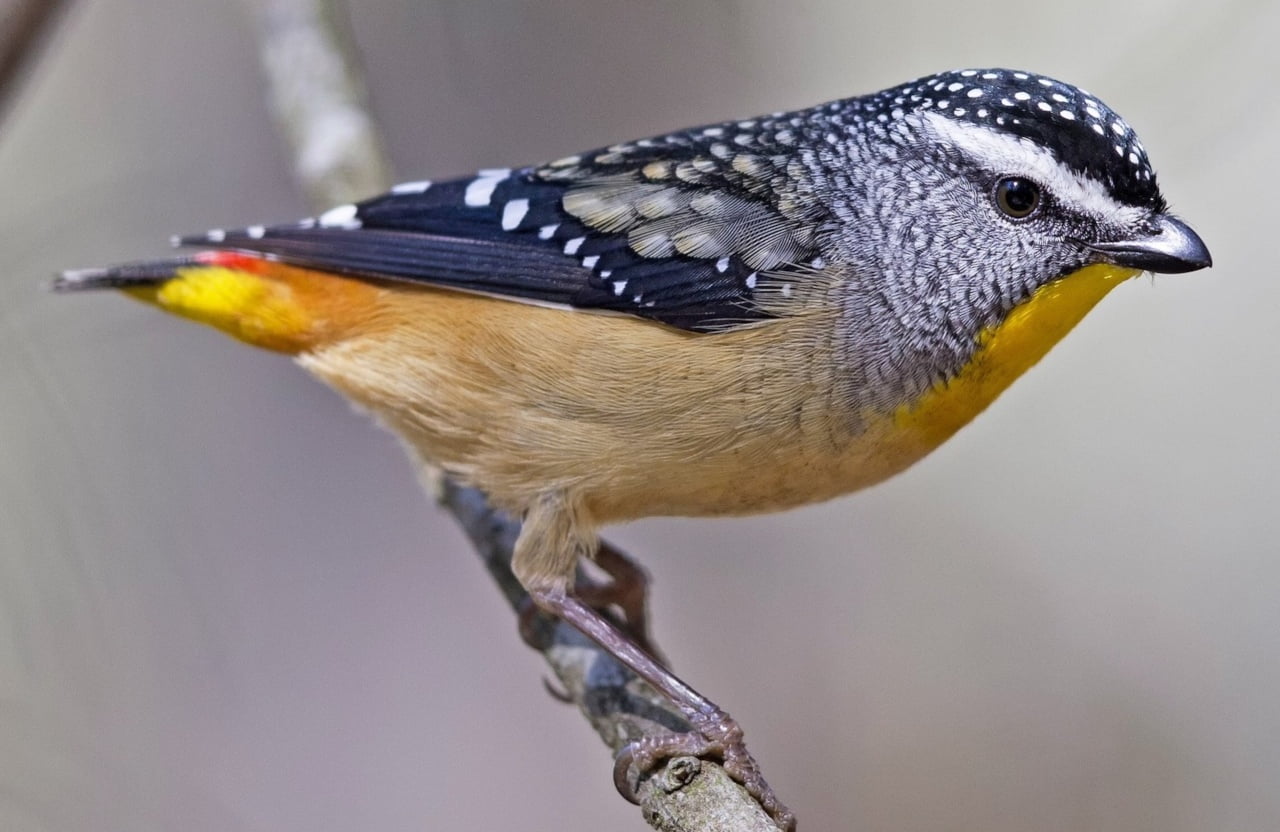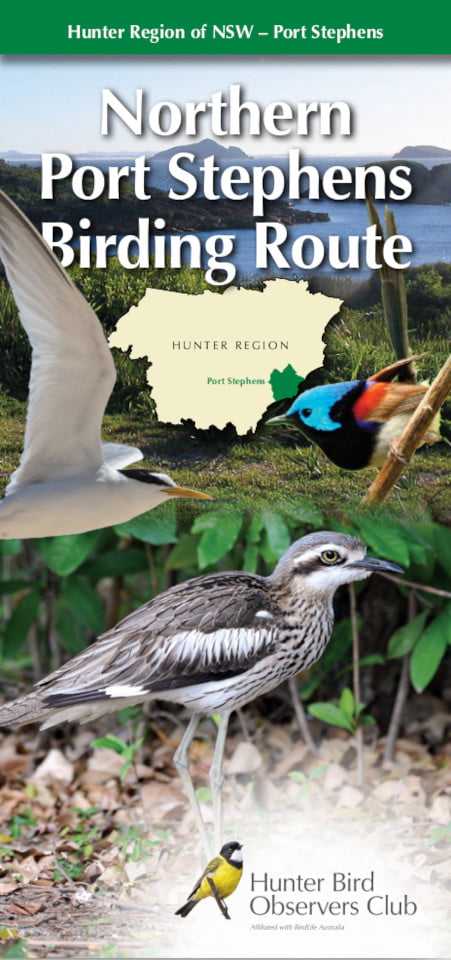My favourite birding spots in Port Stephens.
By Neil Fraser, Tomaree Birdwatchers.
Bird watchers in Port Stephens are fortunate to be able to select from a wide range of easily accessible local birding locations. There are 327 species recorded across the region and over 70 of these are relatively common.
When going birding it is advisable to first consider what you may or may not see at that time, and the factors that govern occurrence. For example, migratory waders are present in Port Stephens from mid-October to mid-March. At high tide, they retreat to secluded roost sites. So it’s best to look for them in summer, at low tide, on exposed mudflats, mostly west of Soldiers Point. If you are looking for woodland birds, it is best to go early in the morning on a sunny day. The warmth of the morning sun gets the insects moving, providing foraging opportunities for many species. Woodland birds are also more active in spring and early summer when they are establishing territories, building nest and feeding young.
Many of the larger avian species are very mobile and follow the availability of food resources across the landscape. This is particularly so of some of the honeyeater species. Locally, Swamp Mahogany flowers from late autumn to early spring providing a reliable source of nectar which attracts an influx of lorikeets, honeyeaters, wattlebirds and friarbirds. Blackbutt also provides a source of nectar for these species between July and January, but it does not flower reliably every year. The large white flowers of Banksia serrata, which flowers in late summer is also a great attractor of nectivorous birds and the seed cones are the favourite food of Yellow-tailed Black-cockatoos.
Other birds that follow the availability of resources are the frugivorous species. Morton Bay Figs and Camphor Laurel which flower from February to May are favourites of many pigeon and dove species, figbirds, bower birds and orioles. These species will also forage on pittosporum in spring and early summer. Our local Gymea Lily which flowers late winter to early spring, is irresistible to many small and large honeyeaters.
A number of different habitats can be found around Port Stephens, each of which has a different assembly of avian species. These include coastal woodland, paperbark swamp, open grasslands, mudflats and beaches, mangroves and samphire, as well as fresh, brackish and saline water bodies. Some of my favourite locations are described below. Further details of some of these can be found in the previously mentioned birding route guides.
Around the shorelines




The shorelines of Port Stephens provide habitat for a range of shorebirds and waterbirds that can be seen all year round. Commonly seen species include Black Swan, Masked Lapwing, Silver Gull, Crested Tern, Australian Pelican, White-faced Heron, Australian White Ibis, and four cormorant species.
When birding around our shorelines, look out for our iconic raptors including Osprey, White-bellied Sea-Eagle, Brahminy Kite and Whistling Kite, all of which forage for fish. Raptors are seen more commonly around shorelines west of Soldiers Point.
Dowadee Island is located immediately west of the northern tip of Soldiers Point Peninsula. The island is owned and managed by the Worimi People. The sandy beach on the southeast end of the island is a high tide roost for a number of shoreline and waterbirds birds and can be viewed from the Soldiers Point boat ramp at Mitchell Street, or from the docks of the Soldiers Point Marina at Ridgeway Avenue. A beach on the southern end of Bushy Island, immediately north of Dowadee Island is also used as a high tide roost. Birds commonly seen roosting on the islands are Beach Stone-curlew, Australian Pied Oystercatcher, Sooty Oystercatcher, Crested Tern, Australian Pelican, White-faced Heron, Little Pied Cormorant, Great Cormorant, Little Black Cormorant and Pied Cormorant. Over summer migratory shorebirds may be present including Whimbrel, Far Eastern Curlew, Bar-tailed Godwit and Grey-tailed Tattler. Dowadee Island is a breeding location for Beach Stone-curlew and Australian Pied Oystercatcher.
Sunset Beach is adjacent to Pearson Park on the western end of Soldiers Point Peninsula. Access is from Elk Street, via Bagnall Avenue. At low tide shoreline and waterbirds can be seen foraging across the exposed sandflats. In addition to the more common species Beach Stone-curlew, Australian Pied Oystercatchers, Sooty Oystercatchers, Striated Heron, Great Egret and Little Egret can be seen. Beach Stone-curlew are most frequently seen with a juvenile between March and May and then prior to commencing breeding in July and August. The birds forage for soldier crabs at low tide. Whimbrel, Far Eastern Curlew, Bar-tailed Godwit and Grey-tailed tattler can also be seen foraging at low tide during summer. At high tide, a storm water drain and rock wall at the southern end of Sunset Beach is used as a high tide roost by Australian Pied Oystercatcher and Sooty Oystercatcher.
The Winda Woppa Sandspit, the nearby sand islands and rock wall at the mouth of the east arm of the Myall River, and the adjacent shores of Corrie Island are high tide roosts for a range of shorebirds and waterbirds. Access is from Winda Woppa Recreation Reserve on The Anchorage, and then via a track through the adjacent tidal wetland and coastal woodland. In addition to the more common species, Australian Pied Oystercatcher and Sooty Oystercatcher, Striated Heron, Red-capped Plover and Caspian Tern are present all year round. In summer, migratory waders including Far Eastern Curlew, Whimbrel, Bar-tailed Godwit, Red-necked Stint, Grey-tailed Tattler and Little Tern are present. Double-banded Plover, which migrate from New Zealand, are present from March to August. Red-capped Plover and Australian Pied Oystercatcher have been recorded nesting on the sand spit. In the past Little Tern have also nested there in summer.
In Salamander Bay, an area of sandflats with adjacent mangroves at the mouth of Mambo Creek is used for foraging by shorebirds and waterbirds at low tide. As well as the common species listed above, Far Eastern Curlew, Bar-tailed Godwit and Grey-tailed Tattler can be seen foraging at in summer. Birds frequently perch on the oyster racks. Access is from Roy Wood Reserve and from Foreshore Drive.
Across the Wetlands
There are many wetlands across the Port Stephens area but most are difficult to access. The most productive and accessible wetland around Port Stephens is the Salamander Wetland adjacent to the Salamander Bay Sports Complex. Access is via Tarrant Road, off Soldiers Point Road, next to the Recycling Centre. Parking is available at the entrance to the sport complex. An abandoned road can be accessed from the main parking area, or across from the recycling centre, which provides easy walking access along the eastern side of the ponds. Two large freshwater collection ponds and a connecting channel support around 35 species of wetland birds.
The commonly recorded species that can be seen all year round include the following: Black Swan, Hardhead, Pacific Black Duck, Grey Teal, Chestnut Teal, Australian Wood Duck, Australasian Grebe, Purple Swamphen, Dusky Moorhen, Eurasian Coot, Masked Lapwing, Australian Pelican, Nankeen Night-Heron, Great Egret, White-faced Heron, Australian White Ibis, Straw-necked Ibis, Royal Spoonbill, Little Pied Cormorant, Great Cormorant, Little Black Cormorant, Pied Cormorant and Australasian Darter. Latham’s Snipe can occasionally be seen in summer. Birds that have been recorded breeding on the ponds include Black Swan, Little Pied Cormorant, Little Black Cormorant, Australasian Darter and Dusky Moorhen.
Through the Woodlands
Port Stephens is fortunate to be surrounded by thousands of hectares of national parks and nature reserves which provide protection for many species of native fauna and flora as well as the adjacent shorelines and waterways. These include Gir-um-bit NP and State Conservation Area, Karuah NP, Myall Lakes NP, Tilligerry NP, Tomaree NP, Worimi NP, Bushy Island NR, Corrie Island NR, One Tree Island NR and Snapper Island NR.




My favourite woodland birding area is a section of the Tomaree NP behind Fingal Bay. This area is not featured in HBOC’s birding route guide. The area is comprised of a mixture of coastal woodland, wet sclerophyll forest and heath, and is accessed by well-maintained fire trails that extend from Big Rocky in the south to Fingal Bay in the north. Entry to the fire trails is from the carpark of the Fingal Bay Bowls Sports & Recreation Club or from the small park at the front of the club. A gully running from the east along the 3F-5F Link Trail is one of the most productive sites in the area. Birds are most easily seen when they are at their most active in spring and early summer.
Around 87 species of woodland birds have been recorded in the area and commonly recorded species that can be seen all year round include the following: Crested Pigeon, Fan-tailed Cuckoo, Sacred Kingfisher, Laughing Kookaburra, Yellow-tailed Black-cockatoo, Galah, Eastern Rosella, Rainbow Lorikeet, White-throated Treecreeper, Variegated and Superb Fairy-wren, Scarlet Honeyeater, Noisy Friarbird, White-cheeked Honeyeater, Eastern Spinebill, Lewin’s Honeyeater, Little and Red Wattlebird, Yellow-faced Honeyeater, Noisy Miner, White-throated Gerygone, White-browed Scrubwren, Brown Thornbill, Black-faced Cuckoo-shrike, Rufous and Golden Whistler, Grey Shrike-thrush, Eastern Whipbird, Australian Figbird, Pied Currawong, Australian Magpie, Grey Butcherbird, Grey Fantail, Australian Raven, Magpie Lark, Eastern Yellow Robin, Red-browed Finch, Welcome Swallow and Silvereye.




The woodland that surrounds the Salamander Wetland (described above) has around 103 recorded species of woodland birds, many of which are also present in the Tomaree NP behind Fingal Bay. The woodland is accessed via the abandoned road through the area. Additional woodland species that are commonly recorded here all year round include the following: Spotted Dove, Bar-shouldered Dove, Azure Kingfisher, Little Corella, Scaly-breasted Lorikeet, Brown Honeyeater, Spotted Pardalote, Yellow Thornbill, Olive-backed Oriole, Pied Butcherbird, Willy Wagtail, Torresian Crow, Australasian Pipit. Australian Reed-Warbler and Common Starling. Dollarbird are commonly recorded in summer. When visiting the location, check out the Osprey nest on the light tower at the sports fields. The birds use the nest most years from July and September.
Where to go birding this Spring
Soldiers Point is one of the best winter birding sites. From the boat ramp or the marina, waterbirds and shorebirds can be seen roosting at high tide on nearby Dowadee and Bushy Islands. From Pearson Park at high tide, Pied and Sooty Oystercatchers can be seen roosting at the south end of Sunset beach. At low tide, over-wintering Far Eastern Curlew and Bar-tailed Godwit can be seen foraging at the same location, and you might also be lucky enough to see the local Beach Stone-curlew.
Woodland birds are best seen around the Salamander wetlands. Many of them will be engaged in establishing breeding territories and nest building, and consequently will tend to be more visible.
The inclement winter weather provides an opportunity to see some offshore birds around the shores of Shoal Bay. Gannets, shearwaters and terns will come inside the bay to forage when conditions offshore become too rough.
Neil Fraser has been an active birder for over 25 years and a member of HBOC for over 20 years. He is joint editor of the HBOC journal The Whistler. Neil has a particular interest in shorebirds and participates regularly in surveys of the Worimi Conservation Lands section of Stockton Beach and the Gir-um-bit NP at Swan Bay. He also regularly surveys the woodland birds in Mambo Recreational Reserve.
The Hunter Bird Observers Club has produced three birding guides for the Port Stephens region which are available to download from the HBOC website.




